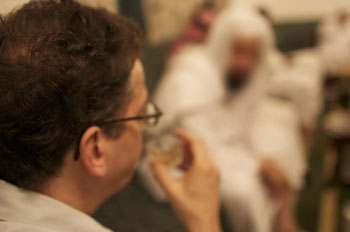 Stuffed with dates, bloated with tea, and in the midst of a pitched battle about Israel’s right to exist, I blurted: "Look, I can’t have the discussion about the Canaanites, again!" (To wit: who was stomping around the Holy Land first, 3,500 years ago!) "Tell me the name of the great fish restaurant around here, Al, something you mentioned it earlier?"
Stuffed with dates, bloated with tea, and in the midst of a pitched battle about Israel’s right to exist, I blurted: "Look, I can’t have the discussion about the Canaanites, again!" (To wit: who was stomping around the Holy Land first, 3,500 years ago!) "Tell me the name of the great fish restaurant around here, Al, something you mentioned it earlier?"
It was New Year’s Eve – the Western one. Saudi Arabia uses the Hijra calendar, which is 11 days shorter than the Gregorian, in case you want to book ahead for next year. I had come to research a Hilary Mantel novel I’m adapting for a film. I was in Jeddah, on the Red Sea. There are two Saudi Arabias. The liberal progressive folks in Jeddah, and cities along the coast, known as the The Hijaz, who summer in Europe and Beruit, read the New York Times on line, whose kids go to schools abroad, decry the religious conservatives, and those in Riyadh, the capital, in the middle of the country and the Eastern Provinces. Blue states, red states.
The popular Sheik, whose home I was visiting in, in Jeddah, had a foot in both camps. He was a charming, gregarious host (the Saudis, in general, are extremely friendly, warm, and generous, contrary to what one might expect) and he had been plying me with a multitude of middle eastern sweets, in addition to the dates, cardamom, coffee and tea, leading up to a ten p.m. dinner. It was going wonderfully, until he made the alarming declaration that "The Jews are welcome in the Middle East, they just can’t have their own country." He didn’t realize I was Jewish when I arrived, but, soon thereafter I had informed him, I was a card carrying member.
My two, gracious Saudi pals – one of them, the son of the Sheik (pronounced "shake") whose views on the subject differed radically from his father, decided it was the appropriate time to high tail it to the restaurant. The Sheik had to stay behind to do a radio interview.
On our way, we drove past the Bin Laden compound, one of them. The Bin Ladens, the Rockefellers of the Saudi Arabia, built the country, and their son, Osama, one of 50 or 55 children (but who’s counting) with the same father and many wives (don’t ask) was the rebellious kid, the black sheep of this proud family, ruining the family name forever.
Al Marjan, an outdoor fish restaurant a few blocks from the beach, was our destination. Marjan means coral. You sit outside, nothing overhead – plein air – on beautiful rugs splayed on the ground, surrounded by a square of low banquets.
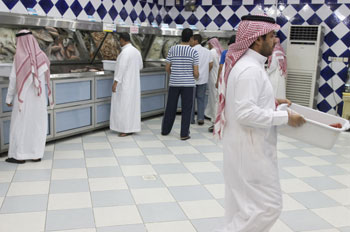
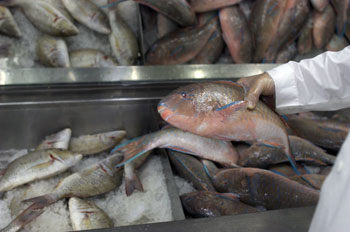
One is led immediately into a room where fresh, not fresh frozen, fish from the Red Sea are constantly being dumped into large bins. You choose which fish you wish to eat, then throw it into a plastic bin, and tell them how you want it cooked: baked or grilled, with options such as date molasses, Tahini sauce, Tamarind sauce, or just straight up. Voila, in 10/15 minutes, it’s brought to your table on a bed of long grained, delicately fragrant basmati rice surrounded by sliced eggs and lemon. You could also have fish soup, followed by fish salad, but I passed. The problem was what to choose? Yellow fin, jack fish, shrimp, lobster, clams, red grouper, tuna, snapper, squirrel fish (nice white tender flesh I was told) unicorn fish, shark, and dozens more you will never find at Santa Monica Seafood.
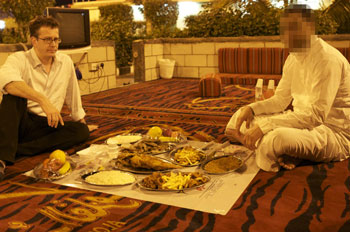 We ate in the traditional style, and depending on who you’re hanging with in Saudi Arabia, normative is the traditional style, to wit: no silverware. The host pinches a piece of fish, or chicken or meat, with his fingers and drops it on your plate. You use Fatir, the ubiquitous Arab bread as a fork, spoon, and my case, napkin. The Saudi are big on tissues, but not napkins. But for me did the tissues tended to stick to my fingers and cheeks. Not a good look. My friends eat meticulously, with only the fingers of their right hand and the bread. The left is used for "hygiene." The one thing you never want to do is eat with, or greet someone, with your left hand in The Kingdom.
We ate in the traditional style, and depending on who you’re hanging with in Saudi Arabia, normative is the traditional style, to wit: no silverware. The host pinches a piece of fish, or chicken or meat, with his fingers and drops it on your plate. You use Fatir, the ubiquitous Arab bread as a fork, spoon, and my case, napkin. The Saudi are big on tissues, but not napkins. But for me did the tissues tended to stick to my fingers and cheeks. Not a good look. My friends eat meticulously, with only the fingers of their right hand and the bread. The left is used for "hygiene." The one thing you never want to do is eat with, or greet someone, with your left hand in The Kingdom.
Over the splendid fish dinner served on a bed of rice, my friend apologized for his father. "My dad (the Sheik) went to high school with Osama Bin Laden (Bin means son of), and when he wouldn’t join him in Afghanistan to fight the Russians, they threatened his life." Talk about burying the lead: "Osama’s high school buddy?" "Yes, but he hates those guys, like most Saudis. You know Bin Laden’s ultimate goal is to bring down The House of Saud. The King. And if that happens, this country," he said regretfully, "becomes the Taliban. We hate Al Quaeda as much as you do. Sure, a minority of rich guys and some in the government supported him, and extremist madrassas around the world, but they were the minority. And most of that has stopped now. Not all, unfortunately, but most."
Before I could respond, a man descended on us with a bundle of short narrow sticks. These Miswak sticks are used to clean the teeth. Unlike a toothpick you chew on it. Although used for thousands of years, it was only a few years ago that the sticks were discovered to contain fluoride.
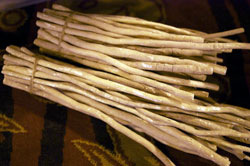
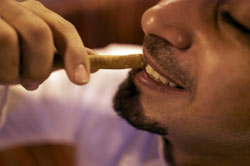
As I was chewing away, my friend’s cell rang. It was midnight, and my friend’s father, the Sheik, was calling to wish me a happy new year, ask me how I liked the food, and apologize for our discussion. I told him the Red Grouper was the best I’d ever had, and reminded him even the Saudi government has promoted a two state solution. He said I was welcome in his house anytime and we should continue our discussion. I proposed that next year we should celebrate New Year’s in Canaan. He paused, then laughed. "Yes, next year with the Canaanites."
Fatir (Flat Bread)
Authentic fatir is made with toasted barley flour, not widely available in the United States. Flour tortillas baked in a warm oven over a metal mixing bowl for 3 to 4 minutes will simulate the
shape of fatir.
INGREDIENTS:
1 loaf frozen white bread dough, thawed according to package directions
Wok
PROCEDURE:
Turn the thawed bread dough out onto a floured surface.
Divide it into 6 pieces. Flatten each piece under the palm of your hand and dust lightly with white flour.
Roll out one piece at a time, keeping the rest covered with a damp dish towel, to make 6 flat breads about 10 inches in diameter. The bread will be very thin, so handle it carefully.
Spray the outside of a wok with cooking spray and set the wok, upside down, over a burner on the stove. Heat it over medium-high heat.
Wearing oven mitts, carefully lay the bread over the curved surface. (This will be awkward. If the mitts make it impossible to handle the dough, use two spatulas or wooden spoons to lift
the dough and drop it onto the wok.)
Press down gently, using a wooden spoon, to make sure all parts of the bread touch the cooking surface.
Cook for 1½–2 minutes. Using tongs, carefully turn the bread over and cook the other side.
When the bread is fully cooked, remove it from the wok and wrap it in a kitchen towel to keep it warm. Cook the remaining breads the same way.
Serves 6 to 10.
